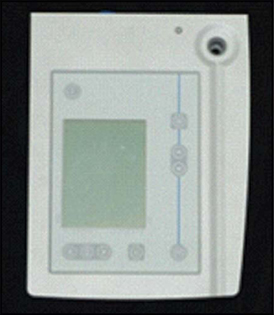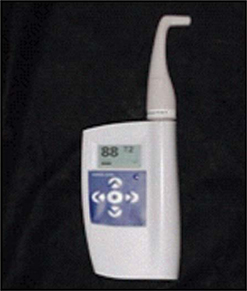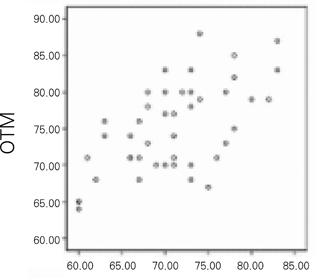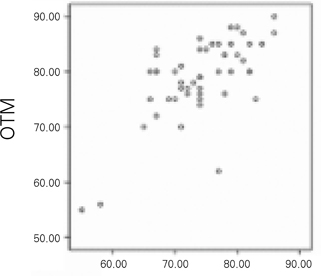J Adv Prosthodont.
2009 Nov;1(3):124-128.
A comparative study on the accuracy of the devices for measuring the implant stability
- Affiliations
-
- 1Department of Prosthodontics, College of Dentistry, Dankook University, Cheonan, South Korea. cho8511@dku.edu
- 2Department of Oral Health Post graduate School of Health & Welfare, Dankook University, Cheonan, South Korea.
Abstract
- STATEMENT OF PROBLEM: How the ISQ values measured by Osstell(TM) and Osstell(TM) Mentor are related, and whether the ISQ values acquired from the two machines changes in accordance with changes in implant stability are not yet fully understood. PURPOSE: The aim of this study was to find out correlation between the ISQ values acquired from Osstell(TM) and Osstell(TM) Mentor, and to evaluate the clinical effectiveness and accuracy of two devices. MATERIAL AND METHODS: Sixty two implants were inserted into 47 patients, and their ISQ values were measured using Osstell(TM) and Osstell(TM) Mentor. In the first stage surgery, the ISQ values of forty four implants inserted into thirty five patients were measured. In the second stage surgery, the values of fifty implants inserted into thirty seven patients were measured. The values were analyzed to determine the difference between the mean ISQ values of Osstell(TM) and Osstell(TM) Mentor. In addition, the correlation between implants used in the first and second stage of surgery with regard to their types and areas of insertion were analyzed. The difference between the ISQ values of 32 implants in each patient during the first and second stage was analyzed. The statistical assessment was carried out using SPSS V. 12.0 for Win. (SPSS Inc., Chicago, USA). The Pearson correlation coefficient was used to examine the correlation between Osstell(TM) and Osstell(TM) Mentor in the first and second stages of surgery, whereas the difference between their ISQ values was evaluated using a paired t-test. RESULTS: In the first stage, the mean ISQ value for Osstell(TM) and Osstell(TM) Mentor was 70.84 and 75.09, respectively, showing a significant difference (P < .01). In the second stage, the mean ISQ value of Osstell(TM) and Osstell(TM) Mentor was 71.76 and 75.94, respectively, also showing a significant difference (P < .01). The difference between the ISQ values in patients in the first and the second stages was significant with both instruments. CONCLUSION: The significant difference in the values obtained using the Osstell(TM) and Osstell(TM) Mentor between the first and second stages of implant surgery indicates that these values can be a convenient and precise way for evaluating the implant stability in clinical practice.
Keyword
Figure
Reference
-
1. Brånemark P, Zarb G, Albrektsson T. Tissue-integrated prostheses. 1985. Chicago: Quitessence Publishing;11–43.2. Choi JW, Heo SJ, Chang IT, Koak JY, Han JH, Kim YS, Lee SH, Yim SH. Resonance frequency analysis of implants with anodized surface oxides. J Korean Acad Prosthodont. 2004. 42:294–300.3. Zarb GA, Schmitt A. Osseointegration and the edentulous predicament. The 10-year-old Toronto study. Br Dent J. 1991. 170:439–444.4. Meredith N. Assessment of implant stability as a prognostic determinant. Int J Prosthodont. 1998. 11:491–501.5. Albrektsson T, Zarb G, Worthington P, Eriksson AR. The long-term efficacy of currently used dental implants: a review and proposed criteria of success. Int J Oral Maxillofac Implants. 1986. 1:11–25.6. Sennerby L, Meredith N. Resonance frequency analysis: measuring implant stability and osseointegration. Compend Contin Educ Dent. 1998. 19:493–498. 500502quiz 504.7. Johansson CB, Albrektsson T. A removal torque and histomorphometric study of commercially pure niobium and titanium implants in rabbit bone. Clin Oral Implants Res. 1991. 2:24–29.8. Wennerberg A, Albrektsson T, Andersson B, Krol JJ. A histomorphometric and removal torque study of screw-shaped titanium implants with three different surface topographies. Clin Oral Implants Res. 1995. 6:24–30.9. Misch CE. Contemporary Implant Dentistry. 1993. St. Louis: CV Mosby;327–354.10. Brånemark PI, Zarb G, Albrektsson T. Tissue-integrated prostheses. osseointegration in clinical dentistry. 1985. Chicago: Quintessence publishing;199–210.11. Park C, Lim JH, Cho IH, Lim HS. A study of the measurement of the implant stability using resonance frequency analysis. J Korean Acad Prosthodont. 2003. 41:181–206.12. Chai JY, Yamada J, Pang IC. In vitro consistency of the Periotest instrument. J Prosthodont. 1993. 2:9–12.13. Derhami K, Wolfaardt JF, Faulkner G, Grace M. Assessment of the periotest device in baseline mobility measurements of craniofacial implants. Int J Oral Maxillofac Implants. 1995. 10:221–229.14. Meredith N, Alleyne D, Cawley P. Quantitative determination of the stability of the implant-tissue interface using resonance frequency analysis. Clin Oral Implants Res. 1996. 7:261–267.15. Meredith N, Shagaldi F, Alleyne D, Sennerby L, Cawley P. The application of resonance frequency measurements to study the stability of titanium implants during healing in the rabbit tibia. Clin Oral Implants Res. 1997. 8:234–243.16. Glauser R, Sennerby L, Meredith N, Rée A, Lundgren A, Gottlow J, Hämmerle CH. Resonance frequency analysis of implants subjected to immediate or early functional occlusal loading. Successful vs. failing implants. Clin Oral Implants Res. 2004. 15:428–434.17. Adell R, Lekholm U, Rockler B, Brånemark PI. A 15-year study of osseointegrated implants in the treatment of the edentulous jaw. Int J Oral Surg. 1981. 10:387–416.18. Lekholm U, Gunne J, Henry P, Higuchi K, Lindén U, Bergström C, van Steenberghe D. Survival of the Brånemark implant in partially edentulous jaws: a 10-year prospective multicenter study. Int J Oral Maxillofac Implants. 1999. 14:639–645.19. Buser D, Mericske-Stern R, Bernard JP, Behneke A, Behneke N, Hirt HP, Belser UC, Lang NP. Long-term evaluation of non-submerged ITI implants. Part 1: 8-year life table analysis of a prospective multi-center study with 2359 implants. Clin Oral Implants Res. 1997. 8:161–172.20. Valderrama P, Oates TW, Jones AA, Simpson J, Schoolfield JD, Cochran DL. Evaluation of two different resonance frequency devices to detect implant stability: a clinical trial. J Periodontol. 2007. 78:262–272.21. Nkenke E, Hahn M, Weinzierl K, Radespiel-Tröger M, Neukam FW, Engelke K. Implant stability and histomorphometry: a correlation study in human cadavers using stepped cylinder implants. Clin Oral Implants Res. 2003. 14:601–609.22. Huang HM, Pan LC, Lee SY, Chiu CL, Fan KH, Ho KN. Assessing the implant/bone interface by using natural frequency analysis. Oral Surg Oral Med Oral Pathol Oral Radiol Endod. 2000. 90:285–291.23. Friberg B, Sennerby L, Meredith N, Lekholm U. A comparison between cutting torque and resonance frequency measurements of maxillary implants. A 20-month clinical study. Int J Oral Maxillofac Surg. 1999. 28:297–303.24. Huang HM, Chiu CL, Yeh CY, Lin CT, Lin LH, Lee SY. Early detection of implant healing process using resonance frequency analysis. Clin Oral Implants Res. 2003. 14:437–443.25. Friberg B, Sennerby L, Linden B, Gröndahl K, Lekholm U. Stability measurements of one-stage Brånemark implants during healing in mandibles. A clinical resonance frequency analysis study. Int J Oral Maxillofac Surg. 1999. 28:266–272.26. Meredith N, Book K, Friberg B, Jemt T, Sennerby L. Resonance frequency measurements of implant stability in vivo. A cross-sectional and longitudinal study of resonance frequency measurements on implants in the edentulous and partially dentate maxilla. Clin Oral Implants Res. 1997. 8:226–233.27. Rasmusson L, Meredith N, Sennerby L. Measurements of stability changes of titanium implants with exposed threads subjected to barrier membrane induced bone augmentation. An experimental study in the rabbit tibia. Clin Oral Implants Res. 1997. 8:316–322.
- Full Text Links
- Actions
-
Cited
- CITED
-
- Close
- Share
- Similar articles
-
- Reliability of implant stability measuring devices depending on various clinical conditions: an in vitro study
- Differences in percussion-type measurements of implant stability according to height of healing abutments and measurement angle
- Clinical Evaluation of the Accuracy of Electronic Home Blood Pressure Measuring Devices
- The effect of undersizing and tapping on bone to implant contact and implant primary stability: A histomorphometric study on bovine ribs
- IN VITRO COMPARATIVE STUDY BETWEEN ISQ AND PERIOTEST? VALUES ON THE IMPLANT STABILITY MEASUREMENTS ACCORDING TO THE INCREASED EFFECTIVE IMPLANT LENGTH






